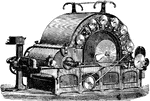Clipart tagged: ‘Carding’

Sectional View of a Carder
An sectional illustration of a carding machine. Carding is the processing of brushing raw or washed…

Carding Process in the Manufacuring of Jute
After the softening process in the manufacturing of jute, the fibers are about six feet long, and are…

Drawing Process in the Manufacturing of Jute
After the carding process in the manufacturing of jute is completed, the jute is taken into the drawing…

Roving Process in the Manufacturing of Jute
After being drawn through the drawing frames during the manufacturing process, the jute slivers are…

Spinning Process in the Manufacturing of Jute
In the last step of the manufacturing process of the jute plant, the material is taken on bobbins to…

